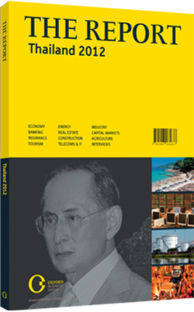After-effects: Severe floods have an impact on the non-life segment, with the government taking action
The worst floods in half a century are having profound effects on the non-life insurance market. What is shaping up to be the third-largest insurance payout in its history is having repercussions not only on the fragmented local market but also on global reinsurance markets (most notably through the Lloyd’s insurance pool in London). As 2012 wears on, the government is planning to guarantee a BT2trn ($63.8bn) natural catastrophe insurance pool to reassure investors that insurance coverage for such events will be available.
UNDER-PRICED RISK: As floods reached crisis levels in Ayutthaya and Pathum Thani provinces, in particular from October to December 2011, 4m homes, businesses and industries were affected, according to AON, an insurance broker with 60% market share of the local brokers market. Lower penetration rates than in Japan helped cushion some of the blow to underwriters, yet the extent of property damage was four times more than that of Japan’s earthquake and tsunami in March 2011. According to the Office of the Insurance Commission (OIC) 1.3m affected households held flood policies. While not considered prone to natural disasters by reinsurers who gradually cut rates over the past decade, Thailand benefitted from low rates for flood insurance, which was bundled for both businesses and consumers. Firms enjoyed automatic inclusion in industrial all risk (IAR) policies, while homebuyers paid only an extra 0.02% of the insured sum for coverage.
Damage was split between the large residential areas affected by the floods in provinces north of Bangkok and seven industrial estates. The Nava Nakorn, Rojana and high-tech industrial estates play host to some of the largest electronics, electronic appliances and automotive producers in the world – all were covered by full-coverage policies from underwriters holding catastrophe agreements with global reinsurers. A full estimate of the total claims will take some time and will likely emerge by the third quarter of 2012, as global insurers tally the costs of policies ranging from property damage to contingent business interruption.
EXPOSURE: In the meantime, both property and IAR claims have already started piling up, with damages concentrated in key insurers on the local market. Global insurers have taken the brunt. As of March 2012 Tokio Marine had provisioned for $2.3bn, Lloyd’s of London $2.2bn, MunichRe $360m, ZurichRe $250bn-300bn, Chartis (AIG’s largest unit) $368m, for instance. Total claims were expected to reach $20bn as of March 2012 according to rating agency Standards & Poor’s.
The three Japanese underwriters present in Thailand saw the biggest local exposure. Other local exposed underwriters, particularly those with equity links to large local banks, have expedited claims processing to facilitate the rebuilding process. Property damage claims reached $15bn by March 2012, according to the OIC. As the claims started to mount, underwriters who previously covered floods at no premium by bundling with full property coverage shunned the market. The unwillingness of many reinsurers to roll over coverage into the first quarter of 2012 caused rates for flood coverage to spike up to 9%. “This is a knee-jerk reaction: as flood coverage is spun off, prices initially spike; but as more insurers gradually re-enter the market and take advantage of high prices, rates will gradually drop over time,” Andrew Bentley, AON’s CEO for Thailand, said.
POOLING RESOURCES: The Ministry of Finance has worked with the OIC to establish a catastrophe insurance fund to normalise flood rates for the domestic market and reassure both investors and households. The pool will cap premiums at around 1% for households (half that for those in non-affected areas) and 1.5% for companies (half for those in “risk-free” zones). The pool will be operated on a voluntary basis and the government expects to cede BT300bn ($9.6bn) of this risk (the total of property damage from recent floods, estimated by the OIC) with global reinsurers in London. Insurers are also now hoping that the government’s ambitious plans for the largest catastrophe insurance fund in the world will be matched by more effective water management and flood prevention measures.
You have reached the limit of premium articles you can view for free.
Choose from the options below to purchase print or digital editions of our Reports. You can also purchase a website subscription giving you unlimited access to all of our Reports online for 12 months.
If you have already purchased this Report or have a website subscription, please login to continue.

